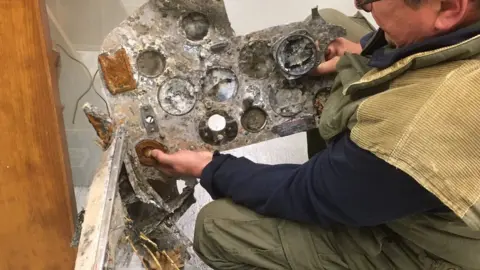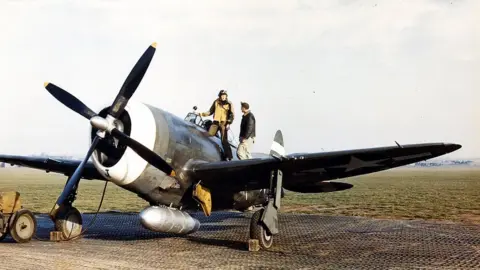World War Two US fighter cockpit found off Suffolk coast
 Guy Campbell/BBC
Guy Campbell/BBCWhat is left of a cockpit from a World War Two US fighter plane has been discovered off the Suffolk coast.
The remains from a P-47 Thunderbolt were dragged up by a local fishing boat close to Covehithe, where three of the aircraft collided in thick cloud in 1944.
It is now at the museum at Halesworth Airfield, where the aircraft took off from.
The museum's Richard Pymar said: "To have this back is just amazing really."
 Getty Images
Getty ImagesThe Thunderbolt was one of the main United States Army Air Forces (USAAF) fighters during the global conflict and was used by the 56th Fighter Group, which was based at Halesworth - one of dozens of bases used by the Americans in East Anglia.
According to records at the museum, the three P-47s took off from the Suffolk airfield on 22 March 1944 to join up with a group of bombers.
But in the thick cloud, they collided and crashed into the North Sea.
The three pilots in the single-seat planes were Donald Funcheon, Claude Mussey and Dale Stream.
Earlier this year, a fishing trawler caught something large in its net and pulled up the remnants of the cockpit from one of the three aircraft.
 Halesworth Airfield Museum
Halesworth Airfield Museum Guy Campbell/BBC
Guy Campbell/BBCMr Pymar said the museum had records of the three pilots and hoped that after the cockpit was restored he would be able to narrow it down to the individual plane.
He said: "It's been very well preserved; hopefully we'll be able to clean up some of the dials.
"We'll treasure it here, also it's a reminder of those young lads and women who served here [and] the bravery of them."
The museum was alerted to the find after the captain of the fishing boat posted details of it on social media.
Paul Starks, a volunteer at the museum, spotted the post. He said the captain had seen evidence on his sonar that pointed to more of the wreckage.
"I spoke to the skipper and he said he could see a lump on the seabed - there'll definitely be more there," he said.
 Guy Campbell/BBC
Guy Campbell/BBC
Find BBC News: East of England on Facebook, Instagram and Twitter. If you have a story suggestion email [email protected]
